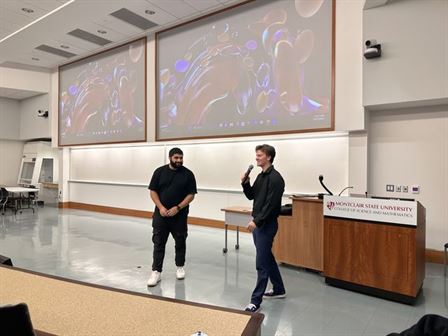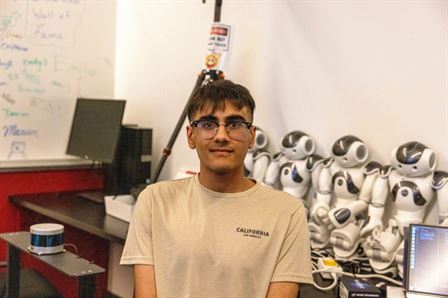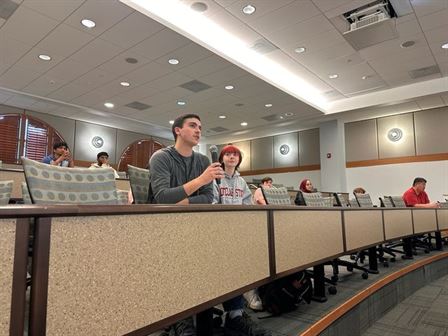Welcome to the world of collaborative robotics, where cutting-edge technology meets hands-on learning, igniting the flames of curiosity and innovation in classrooms across the globe. In this era of automation and artificial intelligence, the integration of collaborative robotics in science, technology, engineering and mathematics (STEM) education stands as an electrifying beacon, preparing the next generation for a future where humans and machines work harmoniously to shape our world.

Omar Obidat and Jesse Parron giving their opening introductions. Photo Courtesy of Jesse Parron.
In an event hosted by the Institute of Electrical and Electronics Engineers (IEEE) Montclair Student Branch, CRoSS Lab, IEEE STEM Champion Montclair Site, and Montclair Robotics Club, students got to experience what it could be like inside of the robotics industry from many lines of business.
Guest speakers Christelle Keefer, director of education, and Sivan Levy, channel specialist for ABB Robotics, attended the event. Their company, ABB Inc., is a Swedish robotics manufacturing company that seeks to delve into the fascinating realm of collaborative robotics, where science, technology, engineering and mathematics converge to inspire the minds of tomorrow’s leaders.
ABB’s mission is to make programming robots as user-friendly as possible. Because of this, they aspire to institutionalize robotics education in STEM curricula around the world.
Amaar Rehman, a junior information technology major, commented on the future of robotics education.

Amaar Rehman, a junior information technology major, expressed his thoughts on the future of robotics education. Photo Courtesy of Sean Kuhn.
“Robotics is expected to keep progressing and take on more significance within the context of education,” Rehman said. “It will give students opportunities for practical learning, encourage creativity and get them ready for future employment or projects in a technologically advancing society.”
ABB sells “collaborative robots” to colleges, which is a term used to describe robots that can safely work with humans in a shared workspace. There are many more kinds of robots used in many different industries. ABB is known to have their robots in the food industry flipping burgers, making coffee like a barista and making cookies. ABB also has robots that specialize in architecture. Some of the robots can 3D print out of metal. There is a bridge in Amsterdam that is entirely 3D printed by one of their robots.
The most popular use case for the robots is in industrial automation, specifically in the automotive industry. Robots are replacing the menial tasks that humans used to do.
Keefer said people of all ages can start to learn about the technology that will be interacted with in the future.
“It is like riding a bike,” Keefer said. “The earlier we expose kids to technology, the better because then they aren’t as intimidated by technology.”
This is especially true when people see how intimidating it can be just looking at a robot let alone programming one. But this is where it is important to target this demographic with educational materials formatted to be easier to understand especially for grade-schoolers.
Jeremy Duran, a sophomore product design major, said that teaching children early could expand their thoughts on what they would like to work on in the future.

Jeremy Duran, a sophomore product design major, believes that teaching robotics to children early could expand their thoughts on what they’d like to work on in the future. Photo courtesy of Sean Kuhn
“[Robotics should be taught] as early as ages six through eight,” Duran said. “Also, robotics being taught in kindergarten through eighth grade would be great for those who aren’t sure what career they want to approach in the future.”
ABB has developed software that specifically helps children program robots that actually work without the knowledge of advanced programming practices that people have studied years for. Their collaborative robots are safe to use and perfect for the educational environment.
Influencing the youth early on is critical to allow for a more diverse STEM community. Keefer commented about the minority of women in the industry.
“I see that there’s a lot of males in the area of engineering and robotics,” Keefer said. “It’s funny because when I go to the different expos, in the events, there’s always a line for the men’s bathroom but when I look at the women’s bathroom, no line. I’m like, ‘This is the best.’ When does this ever happen?”
Keefer leads the effort to reform education by introducing robots early, hoping to inspire more women to pursue robotics and other STEM fields.
But that brings up other issues regarding robots displacing the human workforce. Brandon Matos, a sophomore product design major, said a total takeover is not likely.

Brandon Matos, a sophomore product design major, believes that as new jobs pop up, a total robot takeover is not likely. Photo Courtesy of Sean Kuhn.
“I think there is a big fear of robots and automation eliminating jobs from the working class,” Matos said. “While that may be true, new jobs tend to pop up as a result of automation.”
For those who want to get their foot in the door in the robotics industry, there are many things that can be done. For educators, the ABB offers free training and license of their programs. Teachers can become certified and certify their students with their all-inclusive curriculum. Students also have the chance to work for ABB.
Students interested in finding out more about them as well as research opportunities at Montclair State University should reach out to Collaborative Robotics and Smart Systems Laboratory (CRoSS Lab: www.raiserobot.com) and contact Dr. Weitian Wang, founder and director of the CRoSS Lab.



